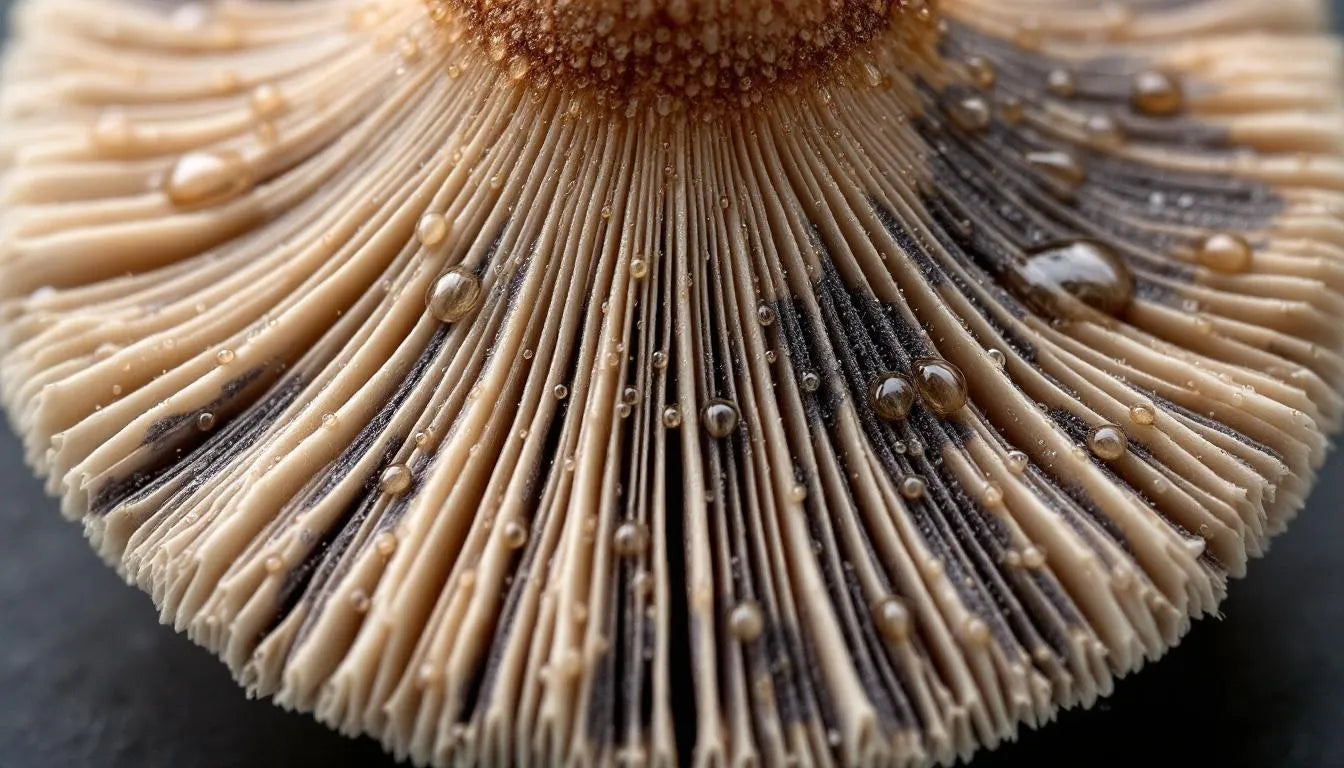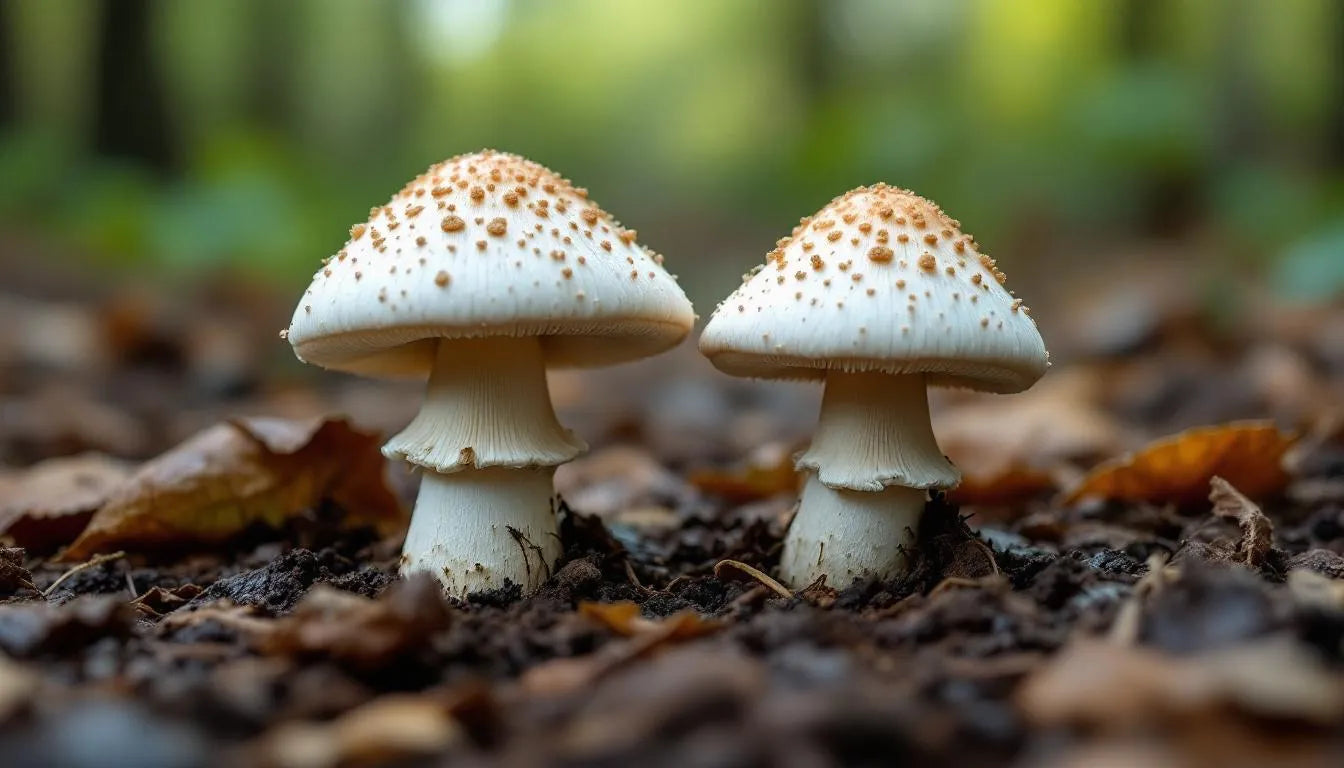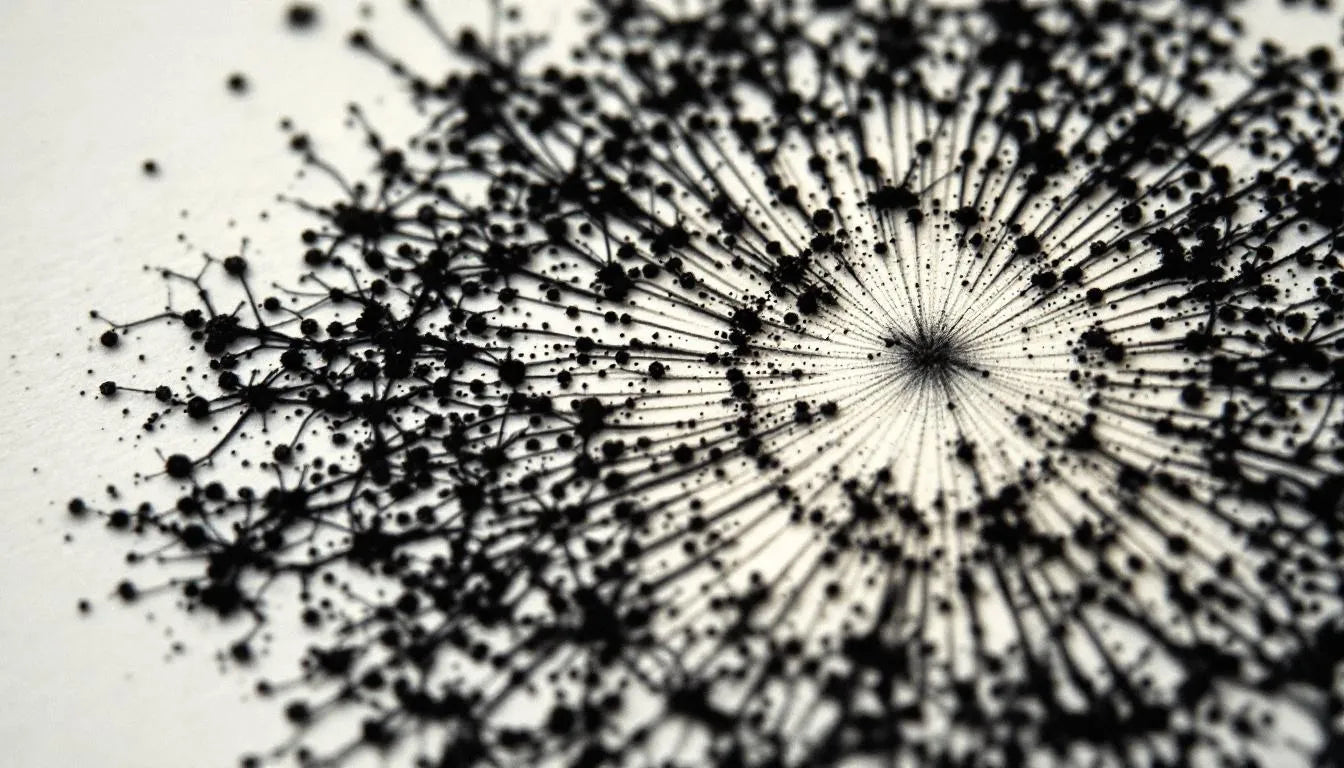⬇️ Prefer to listen instead? ⬇️

- 🔬 Hygrophanous mushrooms change color purely due to moisture content, not chemical oxidation.
- 🌧️ Environmental factors like rainfall, humidity, and wind strongly influence color shifts.
- 🧭 Misidentifying hygrophanous mushrooms can be dangerous, especially when toxic lookalikes are involved.
- 📸 Capturing mushrooms in different moisture states aids identification and documentation.
- 🌱 Cultivation setups provide controlled environments ideal for studying hygrophanous traits.
If you have ever noticed a mushroom changing from dark brown to light tan, you likely saw a hygrophanous species. These interesting mushrooms shift cap color based on how much water they hold, a trait that fascinates both mushroom hunters and scientists. You can even observe these color changes indoors when growing hygrophanous species in Mushroom Grow Bags or a Monotub, where moisture levels are easy to control. This article explains what makes them change, how this helps with mushroom identification, their role in home cultivation, and how to safely study hygrophanous mushrooms in nature or at home.

What Does Hygrophanous Mean in Mycology?
In mushroom science, "hygrophanous" describes mushrooms that visibly change cap color as they get wetter or drier. The word comes from Greek roots hygro- ("moisture") and phanous ("appearance"). This means the mushroom's look depends on water.
You can see this quality in the mushroom's cap, where color changes are clearest. When wet, the cap typically looks darker or richer. As the mushroom dries out, the same cap becomes faded, dull, or see-through.

The Science Behind Mushroom Color Change
What causes this interesting color change in hygrophanous mushrooms? It is about how the mushroom's cells are built and how they react with water and light:
-
Cap Tissue Structure: The cap of many hygrophanous mushrooms is made of thin-walled cells called hyphae. These cells let water pass through easily. When soaked, these cells swell and become more transparent.
-
Light Interaction: As water fills the tissue, light passes through the cap differently. More light is soaked up, and less bounces back. This makes the surface look darker. When the water dries, the cells shrink and spread light out more, so it looks lighter or washed out.
-
No Pigment Change: The color pigments do not change during this process. What changes is how we see those pigments because light passes through the tissue differently.
This water-dependent change can happen fast, even in minutes if it is windy. Or it can happen slowly over hours in humid places. Either way, it shows us the fungus's physical structure and the small areas where it grows.

Why Moisture Matters: Environmental Factors & Hygrophany
Environmental conditions greatly affect how hygrophanous mushrooms show their color changes. These mushrooms are very sensitive to rain, air humidity, sun, and airflow.
Key Environmental Influences:
- Rainfall: After a rain, caps take in water and darken almost instantly.
- Humidity: High air humidity helps keep caps darker longer. Dry conditions make them dry out and lose color faster.
- Sunlight: Sunlight makes water leave the cap surface, which speeds up drying.
- Wind: Gentle breezes can help them dry evenly, but strong wind can dry them in spots.
- Forest vs. Field: Mushrooms in shaded, damp forest floors dry differently than those in open fields under direct sun.
These factors do not just affect how mushrooms look. They often decide when and where these mushrooms grow, how long they live before rotting, and how likely insects are to damage them. Good mushroom hunting often depends on knowing these small environmental signs.

Common Genera of Hygrophanous Mushrooms
Many types of mushrooms show hygrophanous traits. Here are some main ones:
-
Psathyrella: This group includes many fragile, LBMs ("little brown mushrooms"). They change from dark brown when fresh to pale cream or gray when dry. They are good to watch for hygrophany because the cap change is often clear.
-
Panaeolus: This group holds species like Panaeolus cinctulus. They might show color bands as they dry, with a dark center and lighter edges.
-
Inocybe: Most people see these as toxic. These mushrooms have a fibrous cap that loses its shine and deep color as it dries. Color changes are often big and can trick you.
-
Hypholoma: These often grow in clusters. Hypholomas such as H. fasciculare (sulphur tuft) show a clear difference in cap color based on how wet they have been.
When identifying mushrooms in these groups, noting their hygrophanous behavior gives an important trait for identification and study. You cannot see this with just dry photos.

Color Change Patterns For ID: What to Look For
Seeing patterns in hygrophanous mushroom color change makes identifying them much easier and more correct. Here is what to write down when you watch these fungi:
Visual Markers of Hygrophany:
- Zoned Caps: Uneven drying might leave the center dark and edges lighter, or the opposite. This bullseye or halo effect shows water moving out in sections.
- Cap Edge Analysis: Cap edges may dry faster than the middle because more air hits them. Also, they may stay wet if the mushroom is in shade.
- Time-Based Changes: Some mushrooms change color in minutes after picking. Others may take hours. Watching and writing down this change can help you figure out the species.
- Cap Texture: Smooth, thin surfaces are very likely to show hygrophanous changes. Caps that are sticky or jelly-like when wet often change how they look quickly.
Correct color identification needs you to know where the mushroom is in its drying process. This means watching it before, during, and after it partly dries. You cannot just use one picture.

Misidentification Risks and Lookalikes
A big problem with hygrophanous mushrooms is that it is easy to wrongly identify them. Their caps can look very different when wet compared to dry. Because of this, mushroom hunters might think one type is two different ones. Or they might mix up similar-looking mushrooms that are at the same wetness level.
Common Hazards in Identification:
- Toxic Twins: Inocybe species look like Psathyrella or Agrocybe types when fresh or newly dry. Eating the wrong one could make you very sick.
- Under-Dried Misreads: If you judge a mushroom too early in its drying, you might think it is not hygrophanous.
- False Positives: Many mushroom hunters look for psychedelic mushrooms based only on cap color changes. They mix up dark color from water with blue bruising. This can lead to eating bad species.
How to Reduce Risk:
- Take pictures of the mushroom often over time. Write down how its moisture changes.
- Take spore prints from fully dried caps to check if your idea about its family or group is right.
- Look at where it grows, its stem, and how gills attach as main ID tools. Do not just rely on cap color.

Tips for Mushroom Hunters Identifying Hygrophanous Species
Looking for mushrooms in nature is exciting, but you can make mistakes when you do not know how wet they are. Here are good ways to get better at it:
- Use a Moisture Log: Write down the humidity, recent rain, how wet the soil is, and wind levels for each mushroom you find.
- Photograph in Stages: Take pictures when you pick the mushroom, 30 minutes later, and again after an hour or more. Write notes about how they change.
- Test Water Reapplication: Lightly spray the cap with distilled water. See if the color gets dark again. This can show it is hygrophanous.
- Always Spore Test: Wait until the cap is very dry to take a good spore print.
Knowing how long local types take to dry helps you understand how caps act. It also stops you from making expensive mistakes in naming them.

Hygrophanous Species in Cultivation
Mushroom growing kits are great tools for watching hygrophany in a controlled setting. Indoor setups, like those from Zombie Mushrooms, let you see cap color changes caused by water as mushrooms grow.
Cultivation Learns:
- Emergence Phase: Mushrooms come out fully wet. Caps are darkest.
- Maturity Phase: As air moves and water dries, caps get lighter and flatten.
- Spore Drop Readiness: Spores often drop when the cap is partly dry and its edge lifts. This makes hygrophanous effects clearer.
Growers who track cap changes can better pick mushrooms based on what they see. They can also get better photos and records.

Misconceptions About Hygrophanous Mushrooms
It is easy to get wrong what a hygrophanous mushroom is and what it is not. Here are some common false ideas to fix:
-
Misconception #1: "Color change = bruising"
- ❌ False. Color change happens because of water. It is not from chemicals changing or cells breaking.
-
Misconception #2: "It must be psychedelic"
- ❌ Incorrect. Many mushrooms that are not psychedelic, and even toxic ones, show hygrophany.
-
Misconception #3: "They only change color after picking"
- ❌ Not true. Hygrophanous mushrooms change colors even while still growing when they dry out.
Fixing these wrong ideas is important for safe mushroom hunting and good growing.

Case Study: The Psathyrella Family
People often do not give Psathyrella mushrooms enough credit, but they are classic examples of hygrophany. This large group (over 400 species) stands out for:
- Fragile Cap Structure: So delicate that caps often split as they dry.
- Fast Color Change: Changes from dark chocolate brown to pale cream or gray in minutes.
- Found Everywhere: You can find them in lawns, wood chips, and city parks. This makes them good for beginners to watch.
Learning about Psathyrella is a good way to start to understand how mushroom moisture works and to build your skills in the field.

Photography and Documentation Best Practices
Writing down hygrophanous changes is both nice to look at and useful.
-
Camera Tips:
- Use a macro lens for cap close-ups.
- Take pictures on white paper for contrast.
- Take photos before and after drying, from the same spots.
-
Time-Lapse Ideas:
- Use apps that take pictures often, or special camera setups, to watch water leave over hours.
-
Hydration Comparison:
- Make a dry cap wet again. Then compare its colors before and after, in the same light.
Websites like iNaturalist have many hygrophanous photo logs. You can use them to get help identifying mushrooms or to add to science data.

Using Spore Prints with Hygrophanous Mushrooms
Spore printing is very helpful for checking hygrophanous species. Here is how to do it right:
- Wait for Drying: Wet caps often make weak or messy prints.
- Use White and Black Paper: Some spores are white, some are dark. Using both makes it easier to see.
- Color vs Spore Confusion: A tan cap does not mean tan spores. You need to check different features.
Looking at spores closely and knowing the cap's color changes helps you identify mushrooms with confidence.

Practical Mycology: How to Experiment with Hygrophany at Home
You do not need to go into nature to study hygrophanous mushrooms. Try these at-home experiments:
- Humidity Dome Test: Place a fresh mushroom under a glass or plastic dome with water mist. Watch the color get richer.
- Sun and Shade: Put half of a cap in the sun and half in the shade. Then time how fast it changes.
- Grow Kits: Use a setup like Zombie Mushrooms to see how colors change through its life cycle. You can even make picked caps wet again.
These activities are good for people who learn at home, science teachers, and hobbyists.
Mushroom color change is not just a neat trick. It gives practical knowledge about how fungi work and where they grow. But these changes can trick people who are not careful. When you understand how hygrophanous mushrooms act, take good photos, and watch carefully, you will get better at identifying them. And you will like the different kinds of fungi more.
Whether in the woods or your kitchen grow tent, take some time to look closely at color-changing mushrooms. And know this: what you see is not always what you get, especially with fungi.
References
Arora, D. (1986). Mushrooms Demystified. Berkeley: Ten Speed Press.
Kuo, M. (2007). 100 Edible Mushrooms. University of Michigan Press.
Stamets, P. (2005). Mycelium Running: How Mushrooms Can Help Save the World. Ten Speed Press.
Lincoff, G. (1981). National Audubon Society Field Guide to North American Mushrooms. Knopf.



